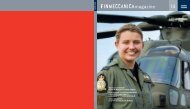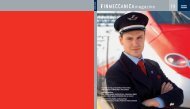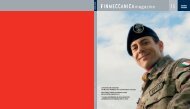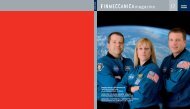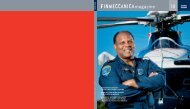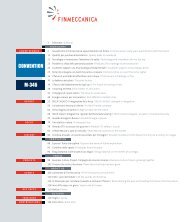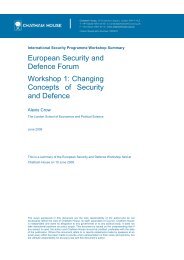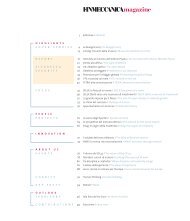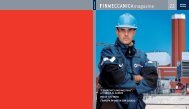E - Finmeccanica
E - Finmeccanica
E - Finmeccanica
You also want an ePaper? Increase the reach of your titles
YUMPU automatically turns print PDFs into web optimized ePapers that Google loves.
H I G H L I G H T S<br />
9/2010 FINMECCANICA MAGAZINE<br />
MEN OF<br />
TELESCIENCE<br />
RTYURUYRTUYRTU,<br />
AS MAJOR PLAYERS IN SPACE DEVELOPMENT, TELESPAZIO<br />
EXPERTS WORK FROM EARTH TO MANAGE THE FLUID SCI-<br />
ENCE LABORATORY DEVELOPED BY THALES ALENIA SPACE<br />
ITALIA ON BOARD EUROPE’S COLUMBUS MODULE, AT-<br />
TACHED TO THE INTERNATIONAL SPACE STATION. WORK<br />
THAT FOCUSES ON THE NEEDS OF THE SCIENTIFIC COM-<br />
MUNITY<br />
Scientific progress is based on<br />
experiments, which in the early<br />
twenty-first century have found<br />
a new and exciting testing ground:<br />
space, or to be precise, the International<br />
Space Station. A new frontier<br />
ripe for exploration by a team of engineers,<br />
scientists and astronauts, all<br />
with a common aim: experimentation<br />
and discovery. The fundamental<br />
contribution to each mission undertaken<br />
by the people and technologies<br />
of Telespazio is now carried out<br />
from Earth in the form of the new<br />
methods of telescience. On 7 February<br />
2008, the European space module<br />
Columbus was permanently attached<br />
to the International Space<br />
Station (ISS), marking the dawn of a<br />
new era for European scientific experimentation<br />
under conditions of<br />
microgravity. The decision to have a<br />
European module that would allow<br />
continuous experimentation in space<br />
dates back to the early 1980s. The<br />
module’s permanent attachment to<br />
the International Space Station represents<br />
the pinnacle of a design and<br />
implementation programme that involved<br />
the European Space Agency<br />
(ESA) and the national European<br />
agencies, all of which were also involved<br />
in implementing a complex<br />
organisational system and intricate<br />
Earth infrastructure to facilitate the<br />
preparation of on-board operations.<br />
The ESA’s operating concept is based<br />
on a network of centres that manage<br />
operations and the archiving of data<br />
from the European scientific payloads<br />
via the central node of the<br />
Columbus Control Centre at Oberpfaffenhofen,<br />
near Munich. Telespazio’s<br />
facility in Naples is one of the four<br />
European centres that have complete<br />
control of one of the Columbus laboratories,<br />
the Fluid Science Laboratory<br />
(FSL), developed by Thales Alenia<br />
Space Italia. All the pre-operational<br />
and operational phases of the laboratory<br />
are managed from the Naples<br />
control room, as well as activities to<br />
promote the scientific use of the facility.<br />
The FSL is a complex laboratory<br />
that required an extremely long commissioning<br />
and on-orbit check-out<br />
phase, including troubleshooting activities,<br />
which were carried out by the<br />
Telespazio team, with the support of<br />
Thales Alenia Space Italia in Turin, via<br />
real-time interaction with the onboard<br />
systems. As Dario Castagnolo,<br />
the key contact for troubleshooting<br />
activities, explains, a salient aspect of<br />
this delicate phase was “the speed<br />
and flexibility with which detailed<br />
technical analysis had to be carried<br />
out and rapidly turned into effective<br />
operating procedures”. Long test and<br />
validation periods were spent in<br />
Telespazio’s clean room working on<br />
the laboratory’s engineering model.<br />
The first scientific experiment carried<br />
out in the FSL at the end of 2008 was<br />
Geoflow, designed to study geophysical<br />
fluid flow under microgravity. The<br />
Telespazio team co-ordinated the operations<br />
of the Spanish support team<br />
and the scientific team from the university<br />
of Cottbus in Germany, where<br />
Geoflow was conceived. These experiments<br />
herald a new way of doing<br />
science. Stefano Tempesta, who as<br />
one of the operation leaders plays a<br />
key role in operational performance,<br />
explains it like this: “At last we are using<br />
the concept of telescience, which<br />
means a virtual presence on board<br />
the module, in order to get the very<br />
best scientific results through the experimenter’s<br />
involvement in real<br />
time.” Each experiment brings with it<br />
an increasing sense of collaboration,<br />
which goes beyond the international<br />
realm and involves many people<br />
working together simultaneously in<br />
real time at locations dotted across<br />
the planet and in space. MVIS was<br />
the next technology experiment, carried<br />
out on behalf of the Canadian<br />
Space Agency and using a system for<br />
minimising the effects of vibrations,<br />
which can have detrimental effects<br />
on experiments under conditions of<br />
microgravity. “Once again, the thorough<br />
preparation and ability to work<br />
in a team, collaborating in real time<br />
with the experimenters on the other<br />
side of the Atlantic and with astronauts<br />
on board, was the key to success,”<br />
stressed Antonio Ceriello, who<br />
managed the project.<br />
But it is not only the FSL experiments<br />
that Telespazio has been<br />
working on in recent years. It has also<br />
been collaborating directly with<br />
NASA on other experiments. Marcello<br />
Lappa and Chiara Piccolo, who coordinated<br />
the preparation and performance<br />
of the experiments, highlight<br />
how “a significant aspect of scientific<br />
experimentation in space is<br />
the need to have an in-depth knowledge<br />
of the phenomena being studied,<br />
which is essential for co-ordinating<br />
and interacting with the many<br />
scientific teams involved during the<br />
crucial phases of the experiment”.<br />
From its Naples base, Telespazio has<br />
also conducted important experiments<br />
with NASA to evaluate the effects<br />
of radiation on the central<br />
nervous system of astronauts. These<br />
experiments were conceived by Professor<br />
Narici at the University of Tor<br />
Vergata and carried out using ALTEA<br />
experimental apparatus, developed<br />
in Milan by Thales Alenia Space Italia<br />
on behalf of the Italian Space<br />
Agency, under the MoMA programme.<br />
In recent years, the Italian<br />
Space Agency has made a significant<br />
contribution to scientific study on<br />
the ISS, especially in the life sciences<br />
and biotech sectors. In this regard,<br />
its starting point has always been to<br />
choose experiments that will also<br />
help to improve the quality of life of<br />
the general population. Last in<br />
chronological terms, but of paramount<br />
international scientific importance,<br />
was the MDS experiment<br />
to study la degeneration of bone tissue<br />
under conditions of microgravity.<br />
This experiment was designed<br />
and carried out from the Telespazio<br />
control room in Naples with realtime<br />
scientific co-ordination by Professor<br />
Cancedda of Genoa University<br />
and technical support from Thales<br />
Alenia Space Italia. This was “an experiment<br />
carried out using for the<br />
first time live mice, which were mon-<br />
itored for over 100 days in orbit before<br />
they returned to Earth,” explains<br />
Renato Vicinanza, who co-ordinated<br />
the experiment. The expertise and<br />
commitment of Telespazio employees<br />
have been key components in<br />
the success of many other missions<br />
and experiments conducted on both<br />
the ISS and all the other available<br />
space platforms. Some of the hallmarks<br />
of the work undertaken include<br />
attention to the needs of the<br />
scientific community and a focus on<br />
improving the data and results for<br />
the benefit of science, applications<br />
and education. To this end, Telespazio<br />
is involved in important European<br />
projects. In the immediate future,<br />
Telespazio will be at the forefront of<br />
the success of various Italian and international<br />
missions and experiments.<br />
In prospect are Roberto Vittori’s<br />
future mission for the Italian<br />
Space Agency, NASA’s Fundamental<br />
and Applied Studies of Emulsion<br />
Stability (FASES) in the FSL, the<br />
FASTER experiment and new experiments<br />
on the effects of radiation on<br />
humans in space, all of which see<br />
the International Space Station as<br />
the foremost outpost of space exploration.<br />
Above: the International Space Station (ISS)<br />
in its current configuration in orbit around<br />
the Earth. Right: the Telespazio Control Room<br />
in Naples during the conducting of the<br />
Geoflow experiment on the ISS<br />
Above: the Geoflow experiment<br />
container used in flight. The central glass<br />
sphere used to simulate the Earth’s<br />
liquid core is clearly visible<br />
28 29



